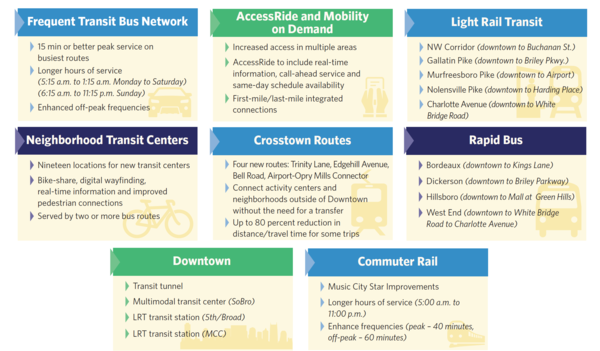
Nashville is now less than a month away from the start of early voting on its mass transit referendum. Voters will decide whether to raise four types of taxes to create a dedicated funding stream for a multi-billion-dollar overhaul to public transit.
Two polls released in March show that many voters (potentially 34 percent) are still undecided or feel they don’t know enough about the plan to take a side. That’s despite a ramping up of messaging directed at voters by groups both for and against the proposal.
As for the actual 55-page transit improvement program that will go in front of voters — it remains unchanged.
WPLN will publish more stories about the referendum in the weeks before the vote. This post focuses on highlighting the key details.
Bus Enhancements And New Rail
The project would be the largest civic investment in Nashville history. Broadly, it’s comprised of three major changes:
- significant improvements and additions to bus service
- construction of five new light rail lines
- the construction of an underground tunnel and transit station beneath the heart of downtown Nashville
Bus enhancements (see the plan, page 11) would seek buses that run much more frequently, as well as longer hours. There would be new routes added — including crosstown paths that don’t flow through downtown, as most routes currently do — as well as four new rapid bus lines. The rapid buses would allow the drivers to trigger faster green lights at intersections, and it would create dedicated bus-only lanes in some areas, for efficiency.
The much-discussed light rail lines connect to downtown from five directions — along Charlotte Avenue, Nolensville Pike, Murfreesboro Pike, Gallatin Pike and a northwest route along a former freight line near Tennessee State University.
The routes range from 2 to nearly 9 miles.
Adding together the four rapid bus routes, five light rail lines and the existing Music City Star commuter rail would make for 10 high-capacity routes branching out like spokes from downtown.
The transit tunnel, which would be bored deep beneath downtown, is described in the plan as a route exclusive to trains and buses, providing a way to navigate the city’s busiest hub (plan pages 27 and 28).
The program calls for 19 new “transit centers” across the city — including two in the tunnel — which would be more robust than current bus stop benches.
Other pieces of the plan include expansion of the Music City Star commuter rail, expanded on-demand AccessRide and new maintenance facilities. In one section, the proposal breaks the plan into eight categories:

Stated Mission
Reducing traffic congestion is the priority — and the plan outlines additional goals that inform its design:
- to guide the city to “grow with intention,” by encouraging density over sprawl
- to provide transit service within a half-mile of 76 percent of all residents
- to boost the economy by improving access to job centers
- to improve pedestrian safety
The plan also attaches numerous ripple effect benefits to the core mission, such as improving health and improving perceptions of the city as a friendly, accessible destination.
But for each point in the plan, opponents have rebuttals. Among the common critiques is the proposal’s focus on light rail — which does not reach to the surrounding counties — and the anticipated disruption to daily life during years of construction.
Some argue the proposal does not do enough for low-income Nashvillians, that the proposed tax increases are too big of an ask, and that the funds could be put to better use.
Costs And Financing
Before the referendum was officially prepared for voters, policymakers argued over which price tag to attach to the brief wording on the ballot. This is what will appear in front of voters.
At issue was whether to show a figure of $5.4 billion or $8.9 billion, and ultimately both numbers will be on the ballot.
Here’s where those figures come from:
- It’s more than $5.4 billion in capital costs to build everything in the plan — the road and rail projects and the new buses and trains and stations and stops.
- It’s closer to $9 billion to do all of that construction and to operate the system for 15 years.
- Because Metro would issue bonds, the resulting debt service plan actually runs until 2060 and would require a total amount that is much greater.
The largest share of the cost — 61 percent — pertains to the rail corridors (plan page 50).
The strategy for paying these amounts is crucial to the plan. After the state legislature passed the IMPROVE Act, localities were allowed to dedicate portions of tax revenues explicitly to transit projects, and that’s what Metro is seeking to do.
The plan asks voters to approve four tax increases: the local sales tax, hotel occupancy tax, business tax and local rental car tax (plan pages 39 through 43).
The idea behind this funding method is to create a dedicated stream of money to support construction and continued operation of a transit system, although opponents have suggested alternatives.
The plan estimates those tax revenues would account for 38 percent of the funding. Roughly 34 percent would be borrowed through bonds and 16 percent would come from federal funds. Sources like fares collected from riders would be one of the smallest funding sources.
Early voting runs April 11-26, followed by the referendum on May 1.
Voters must decide whether they support the 55-page plan and the tax increases that drive its financing strategy. If approved, that plan could not be significantly altered without council approval and an additional public vote — although many of the particulars, such as where individual transit stops would be located, are allowed to be determined later.

